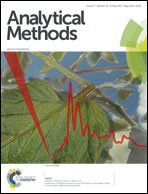On-column preconcentration in sequential injection chromatography: application to determination of parabens
Abstract
Solid-phase extraction is the most usual technique for analyte preconcentration prior to liquid chromatographic analysis. It involves several time-consuming steps, including cartridge conditioning, sample loading and analyte elution. This work proposes on-column preconcentration in sequential injection chromatography by exploiting analyte retention at the head of the chromatographic column. A relatively high volume of an aqueous sample was carried to the reversed-phase column by water. After preconcentration, a suitable mobile phase was inserted to perform chromatographic separation. The feasibility of the proposed approach was demonstrated by preconcentration of parabens before chromatographic separation and UV detection. A linear response was achieved from 12.0 to 100.0 ng mL−1 (r2 > 0.998) with detection limits estimated to be 3.1, 3.3 and 4.6 ng mL−1 and enrichment factors of 435, 405 and 420 for methyl, ethyl, and propylparabens, respectively. Coefficients of variation for retention time and peak heights were below 2.2%. The proposed procedure can be applied to paraben extraction and preconcentration, presenting advantages such as minimization of analyte losses and contamination, reduction of organic solvent consumption and avoiding additional extraction cartridges.


 Please wait while we load your content...
Please wait while we load your content...